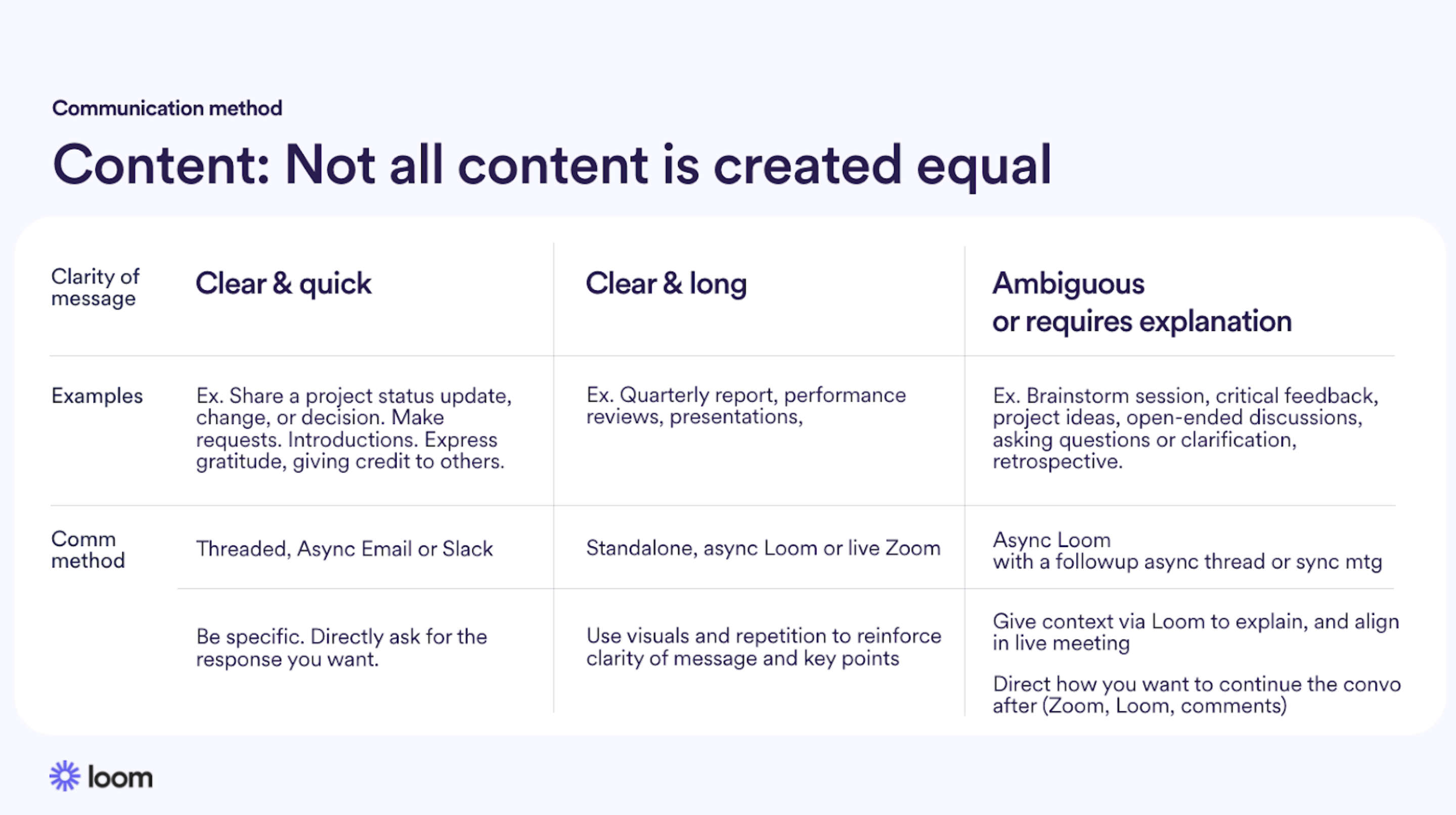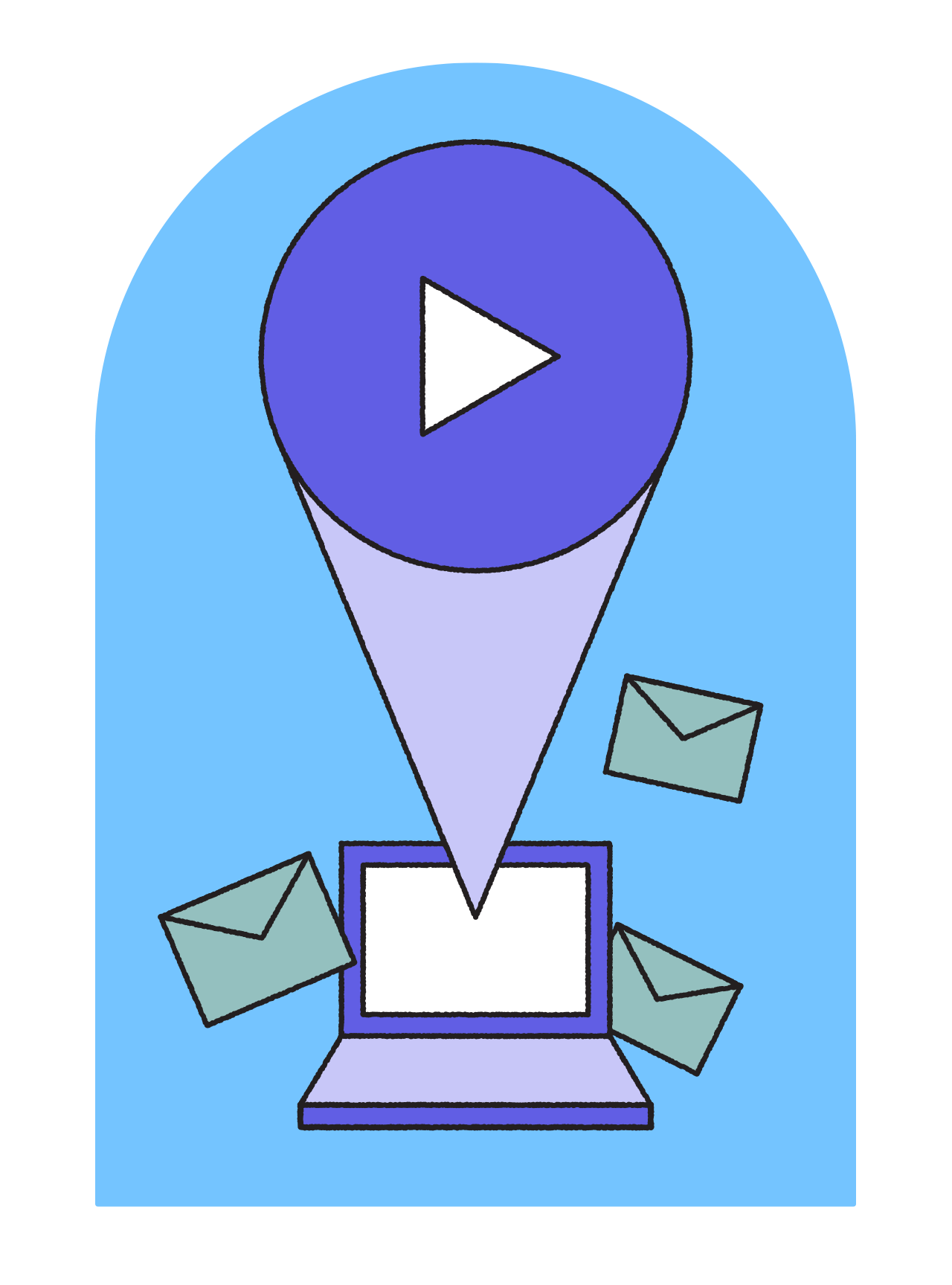The way we work has changed significantly in the past decade—and even more dramatically in just the past two years.
Our work norms, expectations, processes, and go-to tools look vastly different than they did only a few short years ago. One element of work that’s held true? Effective communication is critical to productivity, collaboration, and agility. However, the way we communicate—the channels, modes, and methods—have to evolve alongside our work environment to meet the needs of the modern work era.
The pandemic specifically accelerated the shift to remote and hybrid teams, pushing companies to adopt digital tools that support brand new working environments.
One of the challenges of communication at work today is the plethora of channels. According to Asana, knowledge workers switch between 10 apps 25 times per day. Should my update be an email? Or should it live as a post in a Slack channel? Or, maybe it should just be posted to a JIRA board? The choices are endless.
Even more powerful than having access to new communication tools is knowing how to use them, which ones to use, and when.
At Loom, we’re constantly working on ways to help teams make the most of their time by communicating efficiently in any environment. We recently hosted a live workshop event in which we broke down what effective communication looks like, and ways to unlock it within your own teams.
Why Does Effective Communication Matter?
Whether you’re working in a traditional in-person office environment, working remotely, or partnering with distributed teams across the country and around the world — mastering how to communicate effectively is an unlock for work both at an individual and team level.
The old adage “the work speaks for itself” isn’t as apt as it once was. The odds are you will have to speak for your work, provide feedback for someone else’s work, and decide what you should work on as a team. To do that, you need to be able to communicate clearly and efficiently. So, what does that mean exactly?
Effective communication should do the following:
Build trust and credibility
Provide clarity and direction
Strengthen professional relationships
Engage your audience
Increase productivity
Prevent and resolve problems
Now that we know what end goals we’re looking for, let’s see how we can get there. Here are four pillars of effective communication that you can use to make a bigger impact at work.
Pillar #1: Value People’s Time
Time is the most precious resource we have. To show that you respect other people’s time, invest your own time by preparing for any meetings you’re hosting as well as 1:1s you're participating in.
This doesn’t mean you need to spend hours creating documents for every meeting. It’s more about putting an appropriate measure of thought and intention behind every meeting.
Part of that preparation could mean questioning whether you need to meet at all. Instead of having a weekly meeting, you could ask your colleagues if they’d like to use that time for other work and instead share asynchronous video updates via Loom.
If you do decide to meet synchronously, come in prepared. Before the meeting, draft an agenda that clearly states the reason for the meeting, the schedule of the meeting, and the goals and objectives you’d like to meet.
Be sure to provide the context that attendees will need to understand the goals of your meeting and your work. One great way to do that is by recording a Loom explaining the background of your project. After recording, send out that Loom before the meeting to help everyone get up to speed on their own time, instead of wasting time recapping work at the start of your meeting.
All of these steps not only show your audience that you respect their time, but they also help you increase productivity by adding clarity to projects and tasks that might otherwise be nebulous.
Takeaway Tip: Look at an email or Slack you sent recently and take a pass as making it 20% shorter. This type of exercise can help you identify how to communicate in a more concise manner in everyday interactions.
Bonus Loom Tip: Do a dry run before you record a Loom and when you record, see if you can cut the recording time by 20%.
Pillar #2: Facilitate from the Background
The key to becoming a better speaker and presenter is to become a better listener.
One effective way to run a meeting is to open up the room by gathering your coworkers' feedback and making sure you understand their questions, comments, and concerns.
You might gather consensus by paraphrasing a coworker’s feedback and assuring them you’ve noted it. For example, you might say something like: “Mark, you’d like to make sure all design assets are optimized for the new mobile specs before we push to the next phase? Got it.”
Publicly noting feedback like this shows you value your coworkers’ opinions and gives everyone a clearer understanding of your project’s trajectory.
Once you’ve gathered team feedback and presented your own points, make sure to document actionable next steps. Having a single source of truth that anyone in the meeting can review to make sure everyone’s on track is incredibly helpful to maintain momentum and clarity.
Takeaway Tip: Document or record meeting recaps to preserve project outcomes, goals, and deliverables.
Bonus Loom Tip: With Loom, you can use the transcript feature to quickly provide a read-out of the meeting to participants alongside the action items.
Pillar #3: Read the Room
Be attentive and read the energy of a room whether you’re all hopping on a video call or gathering in a physical conference room. We used to depend on reading body language during in-person meetings, but with hybrid or all-remote groups, we now have to rely on different ways of gauging if folks are engaged.
Take the lead by utilizing facial expressions and tone of voice in intentional ways. For example, smile, raise your eyebrows to punctuate a point, nod when a coworker adds on to your thought. These are all methods for active listening and reduce the barriers for participating.
By setting an example yourself, you create an atmosphere that’s more hospitable to collaboration, whether that’s a coworker chiming in, or simply adding an emoji reaction to your point.
Takeaway Tip: Instead of feeling the pressure to fill silence, try punctuating your points with a little bit of a pause. Research shows that pauses greater than four seconds are uncomfortable, but keeping a pause under that time can help you underline a critical point.
Bonus Loom Tip: Make the Pause button your best friend. Hit pause when you notice yourself starting to ramble. Gather your thoughts for your next point before hitting record again.
Pillar #4: Choose the Most Fitting Method of Communication
Before you send out that calendar invite, stop and ask the following questions:
What is the type of content you’re presenting?
Who is your audience?
What’s your desired outcome?
Answering those questions can help you choose the best method of communication for your project.
You might not need to find time on your team’s calendars when delivering a clear update, or recapping a decision you made. Simply put — not all content is created equally. Pair the type of content you’re sharing to the ideal medium.

For example, you could use Loom’s asynchronous video messaging to post a welcome message introducing a new hire. Or, you could use Loom to explain why you picked one design asset over another. That type of clear content might not necessitate a synchronous meeting.
If you’re sharing content that’s more intricate and dependent on your colleagues' involvement, perhaps host the meeting synchronously and incorporate async videos before and after the event.
Let’s say you’re gearing up for your company’s all-hands. You may choose to post a Loom providing the context for the agenda beforehand. After the meeting wraps up, post a recap video for those who couldn’t make the meeting.
Takeaway Tip: When you’re taking charge of ambitious projects where the goals are more ambiguous and hard to pin down, async videos can help bring clarity to your team.
Bonus Loom Tip: Use the CTA button feature to link to relevant documents and materials in a pre-meeting loom brief. This gives everyone the verbal context in the form of the loom, and the written context ahead of time.
Communication is an Art
These pillars are important pieces of the communication puzzle, but there’s no silver bullet to mastering it across all channels. Communication is a skill you hone over time, not something that you can perfect over a weekend or even a quarter.
As you work to refine the way you communicate with your team, ask for feedback openly and transparently. The more comfortable teams feel sharing feedback with one another, the more they can iterate, collaborate, and get work done without messages getting lost in translation.
When in doubt? Err on the side of over-communication so everyone’s on the same page.

